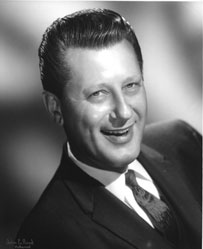The following information came from many sources, and is not guaranteed to be complete or correct. A great deal of information came from perusing the collection of early TV magazines held by the Pavek Museum of Broadcasting, located in St. Louis Park. This task can be difficult, as the collection is both large and incomplete. It is also easy to miss entries, especially since Mel had so many different shows in many different time slots. A man as prolific as Mel Jass is understandably difficult to document. Many thanks to the Pavek Museum for providing access to their materials.
If you’re looking for a bona-fide Twin Cities celebrity, look no farther than Mel Jass. Talk show host, pitchman, actor – Mel was someone that absolutely everyone in the broadcast area knew. His long tenure hosting the “Matinee Movie” on Channel 11 has reportedly inspired the Coen Brothers to try filmmaking, which they did at an early age at their St. Louis Park Home.
EARLY MEL
Mel was born Melvin Frederick Ferdinand Jass on March 24, 1917, on the East Side of St. Paul, and grew up in Rosemount. His father was a sheet metal worker and also a musical and dramatic director. He taught Mel’s mother was also musical, playing the church organ.
Mel took after his father, first learning Mel the violin at age seven and also the reed instruments; at age nine he was playing trumpet in his father’s band, and he later organized his own high school band. He also bragged of being the youngest journeyman sheet-metal worker in St. Paul. He also followed in his father’s dramatic footsteps; he became involved in the old Y Players, the Twin Cities Little Theater Company that preceded the Edyth Bush Theater, the St. Paul Civic Opera (he was in the first three shows), and the old WPA St. Paul Symphony Orchestra.
At age 11 (or was it 9?) he started selling the St. Paul Daily News. of John Dillinger and Ma Barker.
With three or four credits to go, he dropped out of Harding High School and went to work, “selling and promoting.” At one point he was installing furnaces.
In 1939 he hitch-hiked his way west to Helena, Montana, where he was the manager, program director, salesman, and equipment repairman at a small radio station. He worked for the NBC Blue and Mutual networks, and in Salt Lake City, according to Channel 11 records.
Mel served in the Air Force during World War II. While in the Air Force he was involved with stage shows. Mustered out, he joined the radio network headquartered in Butte.
TWIN CITY TELEVISION LAB
Mel joined the Beck School of Radio in 1946, and then the Twin City Television Lab in April 1947. Mel was at the TV Lab from the beginning. The Lab’s purpose was to train personnel in the skills needed in the new television industry. Located in the Lyceum Theater Building at 85 Eleventh Street So. in Minneapolis, the complex occupied over 11,000 square feet of studios, classrooms, and offices over three floors of the building. Mel planned the television production training unit.
In an article in the Fall 1979 issue of Minnesota History, Joe Beck had this to say about Mel:
And there was Mel Jass, my loyal right hand and close confidant for almost ten years. He had made the trip to New York in early 1947 to help pick a staff. Like many others who made the transition to TV, he began his own broadcasting career as a radio announcer and joined Beck [Radio] Studios in 1946. In our young organization Mel was incredibly the right man in the right job at the right time. The only thing stereotyped about his multiple functions was his job title: director of public relations. He was a lot more; he had to be. Maybe it is mixing metaphors, but if I were the company’s “spark plug” (so described by others), Mel Jass was the catalyst that kept things running.
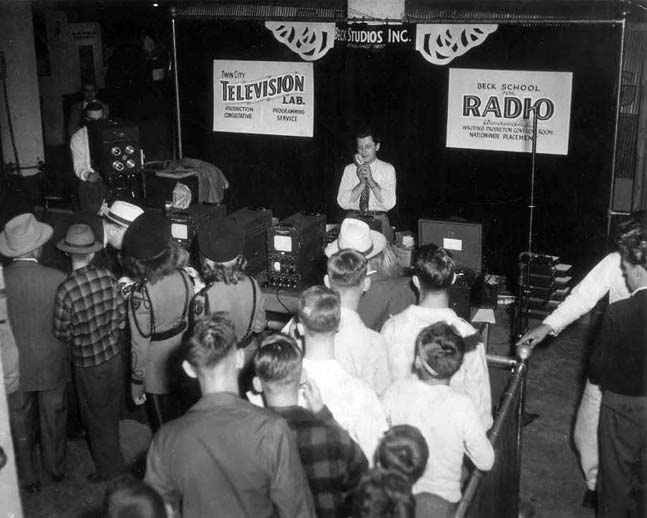
The caption for the photo below reads:
Locally-produced television shows have been in the making at Beck Studios’ Twin Cities Television Laboratory, Lyceum Theater, for many months in preparation for the day when television becomes a household word. Helping to prove that television will not be forced to depend on “canned” programs are Mel Jass, left, Beck master of ceremonies; Bill Gage, Beck technical superintendent; Joseph Beck president, and Joe E. Brown, who appeared in Minneapolis in Harvey.
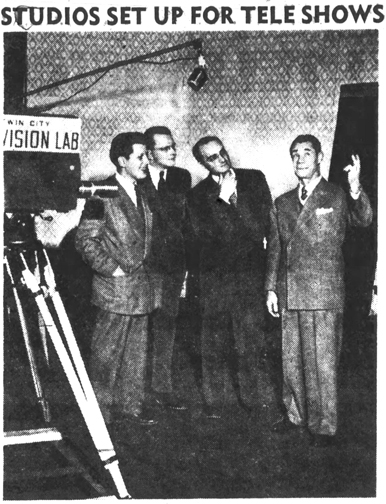
In May 1949, Beck was in a horrific traffic accident that killed his wife and put him in the hospital for five months. Beck wrote:
With characteristic concern and loyalty, Mel Jass, the one staff member competent to carry on, labored long hours to salvage what could be saved of the daily operation, if not the ultimate purpose, of Beck Studios, Inc. and the Twin City Television Lab.
Due to the accident and an FCC moratorium on new TV licenses that lasted three and a half years, the Lab had to close in the fall of 1950.
EARLY LOCAL TV STATIONS
The first TV station in the Twin Cities, KSTP, went on the air on April 27, 1948, on Channel 5.
WTCN, which at that time was on Channel 4, first aired at 6:30 pm on July 1, 1949.
In October 1949, approximately 18,000 homes in the Twin Cities area had television sets. By April 1950, that number had increased by almost 250 percent, to approximately 44,300.
On August 19, 1952, WTCN changed its call letters to WCCO.
A new WTCN emerged on September 1, 1953, on Channel 11.
WCCO
Mel was first recruited as a salesman for TV station WCCO by the station’s sales manager, Bob Eckstrom, “who could always spot a salesman a mile away.” (Julian West)
Eckstrom called one night and told Mel to get down to the station fast because he needed a substitute for an announcer caught in a snowstorm in North Dakota. Mel ad-libbed a number of Plymouth car commercials during a movie, and the response was so good that he was offered the job permanently. He jumped at the chance – although he felt a bit guilty because the man he replaced was a part-time preacher, working in television to pay his church’s bills. (West)
An article from the St. Paul Pioneer Press from 1950 (Town Toppers) says that
He is the only Twin Cities television personality who is a completely free agent, except for an agreement to confine his activities to WCCO-TV. He is at present considering deals to do two series of filmed commercials for national distribution, a process which will require a trip to New York for the filming.
The article also says that his family of five children moved to a house in Minnetonka Beach in September 1950.
WTCN
Mel shows up in the TV listings starting on December 30, 1951, when he took over “Show People” from Jim Boysen. The TV Guide noted, “Mel Jess (sic) emcees this original presentation.” The show aired on WTCN Channel 4 on Sundays at 11 pm. On April 20, 1952, the show was renamed the “Kieffer Club,” and the TV Guide again noted, “Mel Jass emcees this original presentation.” Mel hosted the “Kieffer Club” until September 20, 1952. [The show reverted to “Show People,” described as “Talent on Parade,” with no host listed. The last “Show People” was aired on September 11, 1953.]
Overlapping “Show People” was the first “Mel Jass Show,” which aired from April 28 to December 11, 1952, on WTCN, Channel 4. This show was first aired at 1:30 pm, Monday-Friday. The description was “Hit tunes of the week, guest interviews.” In August 1952, he alternated with Johnny Dugan. On September 29, 1952, the show moved to 11:30 weekdays.
WCCO
On August 19, 1952, Channel 4’s switch from WTCN to WCCO did not affect Mel’s shows, as he stayed at Channel 4 when it became WCCO.
On December 15, 1952, “Mel’s Almanac” appeared, again on WCCO. It aired at different times in the morning on, weekdays.

The description given on April 11, 1953, was “Informality is the Word.” On November 6, 1953, TV Guide said: “Mel Jass’ early morning gang play tunes, sing and read viewers’ letters.” Another promo said “See Mel Jass – [musician] Toby Prin and Newsman Don Padilla – as they bring you local news, weather flashes, household hints, and plenty of easy-going humor – plus a song or two.” The last show aired on March 5, 1954 (replaced with Don McNeil’s “Breakfast Club”).
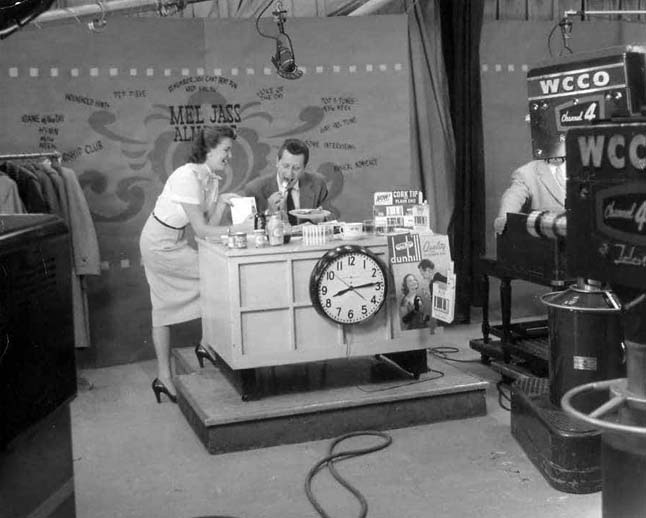
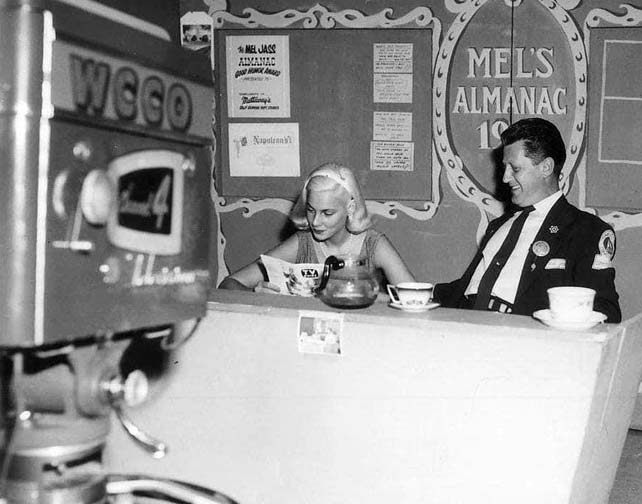
Starting in about May 1953, Mel had a “Mel’s Almanac” column in the TV Guide. It mostly consisted of submitted jokes and household hints.
On April 28, 1954, a new “Mel Jass Show” debuted on WCCO Channel 4 at 2:00 pm, M-F. On July 9, 1954, the show moved to 11:00 am, M-F (although it was sometimes shown at 8:30 am.) It’s unclear when it went off the air, but it may have been as late as November 1957.
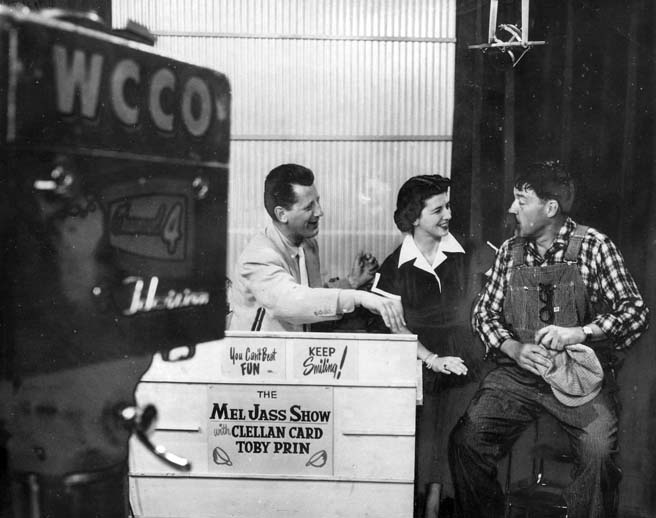
There is a show called “Game of the Day” listed on November 15, 1954 on Channel 4. This may have been a one-time assignment, but maybe not.
The January 7, 1956, edition of the TV Guide reported:
A new show makes its debut on Ch. 4 [on January 3, 1956]: Your Reserved Table. The show will feature top amateur and professional talent in a continuous contest to pick the top performer. The show will be done live remote from the Twin Cities. Emcee, Arnie Walker; Commercial man, Mel Jass; and “Girl Friday,” Lucy Cook, will keep the show rolling. Auditions will be held by Toby Prin…”
The show originated from the Boulevard Twins Restaurant, and featured local talent. On February 14, 1956, Will Jones of the Minneapolis Tribune wrote,
If anybody wonders how Mel Jass can do the studio commercials on a late film show and then turn up doing more commercials on “Your Reserved Table” from the Boulevard Twins restaurant a few minutes later, here’s how he does it:
He merely strolls to another set made up to look like a table at the Boulevard Twins. The rest of the show actually comes from the restaurant. The performers turn their heads the same direction when referring to Jass, to help create the illusion he’s right there.
The last newspaper ad for Your Reserved Table was on May 1, 1956.
A program note from October 6, 1956, indicates that Mel’s “Hobby Showcase” show was moving to a new time (12:30) on Channel 4. It premiered on or before January 1956 through at least December 1956.
For at least a few months, from April 1 to August 9, 1957, Mel hosted “Popeye’s Clubhouse” at 5:30 pm on WCCO Channel 4. He appeared with a sailor hat and a special jacket monogrammed with the name of the show.
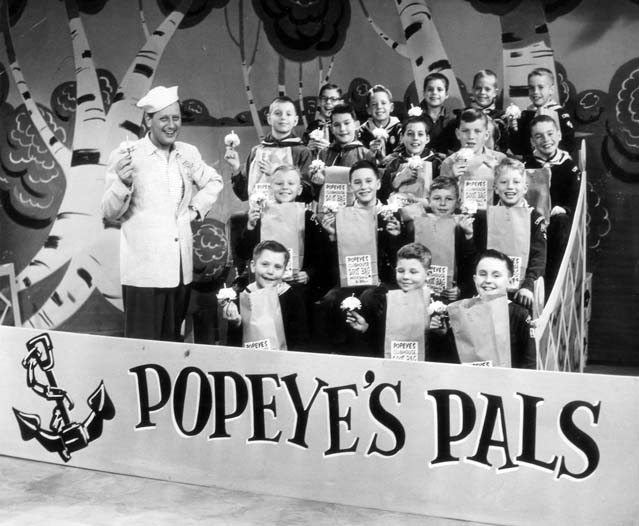
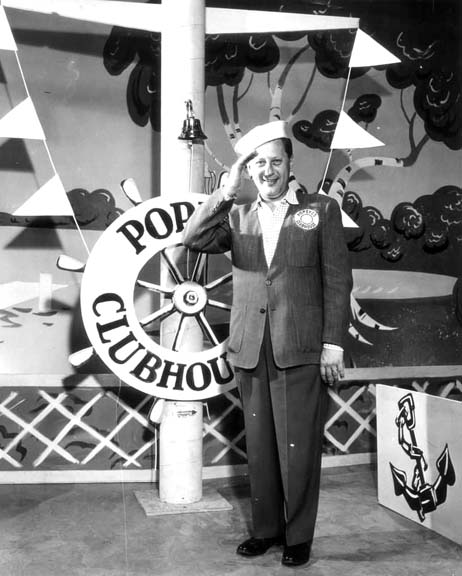
Also in April 1957, starting on the 7th, Mel hosted a new weather program that aired Sunday-Friday after the Hollywood Playhouse. That’s midnight.
WTCN
By May 1957 Mel had been recruited to Channel 11 (WTCN-TV), where he began his 21-year run. One of his first jobs was to host a hobby and sports show.
Another early job at Channel 11 was to anchor the news. An August 1957 Channel 11 program guide shows that Mel Jass News was broadcast at 6:00 pm, followed by Stuart A. Lindman on weather at 6:10, and John Daly News at 6:15. Mel also presented a ten minute news show at 10 pm., all Monday through Saturday.
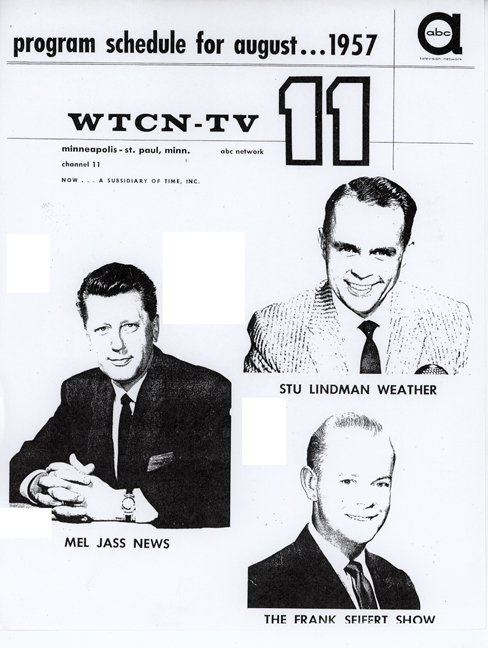
The Mel Jass Matinee Movie probably began as soon as Mel came to Channel 11. Although the TV Guide mostly listed the program as “movie,” most everyone new it by its rightful name. (We may also remember Mel’s “Dialing for Dollars,” but that show was primarily on Channel 5, except for a short time in 1971.) The August 1957 program guide tells us that the Mel Jass Matinee featured “Outstanding Warner Bros. Productions.”
In December 1957, Jass anchored the 6:25 evening news, taking over from John Daly. His delivery was reported to be “bizarre” – perhaps he oversold the product. The show lasted at least until May 30, 1958, but was gone by February 2, 1959. The 6:25 show identified Mel by name. There was also a 10:00 pm news segment listed, but Mel’s name is not associated with it in the TV Guide.
On July 21, 1958, Mel was no longer the 10:00 newscaster or the matinee movie host, but the host of the late-night movies recently purchased by Channel 11.
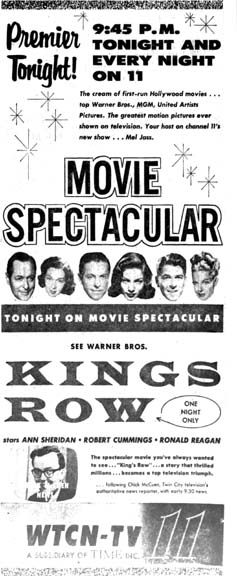
Here’s an interesting column by Will Jones that says that Mel gave up his WTCN staff contract recently to become a TV free-lancer again. It meant giving up the host job on the station’s new “Movie Spectacular,” which had garnered some top late-night ratings and had become a local conversation piece. Mel said:
I’m greedy. and there’s such a thing, in the local emcee business, of a show’s being too successful. When the show is successful, they start selling spots to national sponsors. Those are film spots and they don’t need the local announcer – and the announcer’s income is tied directly to the number of spots he does. The local announcer needs medium-rated shows to stay alive. I’ve made my best living from some of the lower-rated shows. (Minneapolis Tribune, August 13, 1958)
KMSP
On December 1, 1958, Mel moved to KMSP, Channel 9, to host a show called “Open House.” The show consisted of “chatter and interviews.” It was on from 11 to midnight.
Mel put it this way: “We’re not going to have interviews; we’re going to have discussions.” Viewers will be invited to call in their thoughts, or come down to the station and participate. Mel said “We’ll just have a couple of guys at the door to keep out the drunks.” They invited local talent to wander in too.
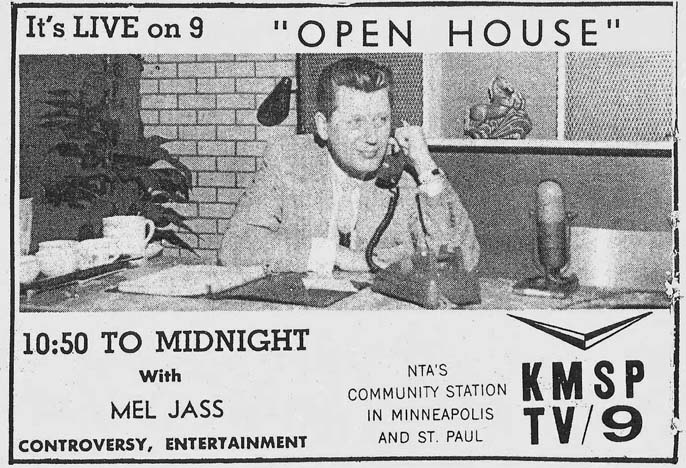
Alas, Will Jones could not get interested in Mel’s discussions, as they just didn’t seem controversial.
A well-informed moderator doesn’t need to have opinions himself to keep a controversial show going. On the other hand, and uninformed moderator can keep a show lively just by expressing opinions – as several Hollywood operators are proving. Jass needles, but without a point of view that is based on opinion or information, and the results have been blah. (Minneapolis Tribune, December 19, 1958)
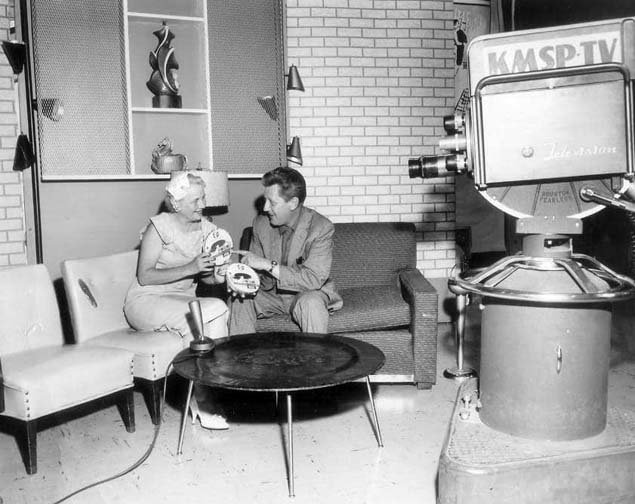
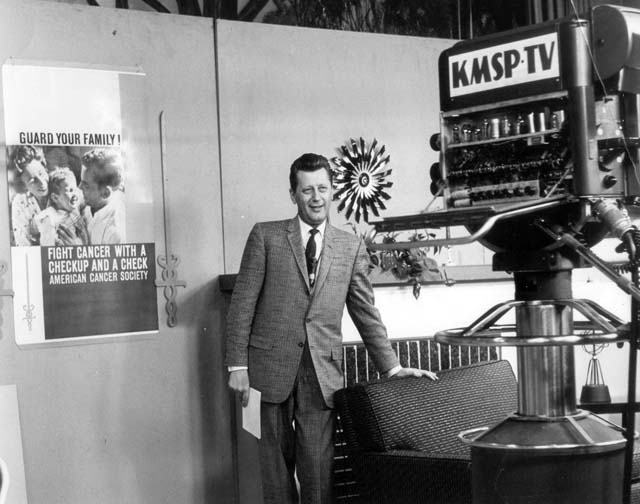
When Channel 9’s programming day began at 11:45 instead of 2 pm, Mel Jass Matinee began showing movies on Channel 9 on February 23, 1959. The show included a bit of “housewife chatter.” It was on from 12:30 to 2 pm. Mel had an appendectomy at the end of March 1959. Both shows ran concurrently. With the addition of some other talk shows from the station’s sister station WNTA in New York, “Open House” was cut to Tuesdays to Thursdays only.

KTTV, Los Angeles
Mel moved to Los Angeles to take over the noon newscast on KTTV-TV on February 22, 1960. KTTV was owned by the Los Angeles Times. His family waited until school was out in June to join him. Mel said he would return to Minnesota about once a month to continue videotaping commercials for local stations. He was a free agent at that time. Mel said in an interview, “The free lance was great when it was good, but there was one period of 14 weeks when I never faced a camera.”
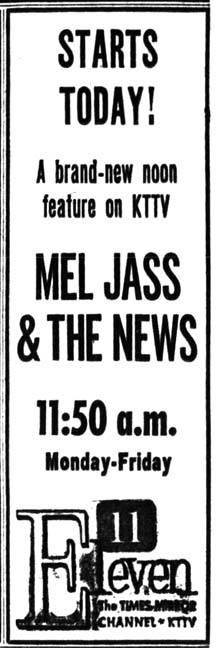
The audition that won him the KTTV job startled the Californians, Jass said, as it was a commercial for snow tires. The station’s news staff was dominated by ex-Mineapolitans; the station’s “High salaried and influential night-time news dramatist” was a former KSTP newscaster. (Minneapolis Tribune, February 15, 1960)
On Saturdays he was expected to conduct the “Junior Auction” show for a local station in Bakersfield. The show, which aired in 21 cities, was owned by Minneapolis ad man Mike Fadell.
The Mel Jass Show aired on KTTV at 11:30 in Los Angeles in March 1961.
By April 1961, Mel was the host of KTTV’s Morning Movie.
ACTING
As noted above, Mel had done some acting in Minnesota, and he tried his hand at acting in Hollywood. The Letovsky interview from 1967 said that he had appeared in 11 movies and TV shows. These include:
- In his entertainment column on December 27, 1961, Will Jones noted that Mel was an uncredited actor in an obscure one-season TV series called “Window on Main Street.”
- “Alfred Hitchcock Presents,” playing the court reporter in the October 11, 1962 episode “I Saw the Whole Thing“
- “87th Precinct” (“Man in a Jam,” 1962)
- “Keyhole” (“Detective for the Defense,” 1961)
- Another show mentioned in the St. Paul Recorder was the Alco Premiere.
- “Leave it to Beaver“
- “The Joey Bishop Show“
- “The Dick Van Dyke Show“
- He also may have been on a soap opera.
- In early 1963 he was expected to shoot a film in Mexico and then play the second lead in a movie to be shot in Munich. (Minneapolis Star, November 14, 1962)
February 9, 1963, issue of TV Times.
WTCN
Mel and his family moved back to Minnesota in November 1962. He decided that Minnesota was a better place to raise kids.
Mel returned to Minneapolis TV on January 28, 1963, to host Mel’s Matinee Movie. He would show films such as “Blondie and Dagwood, “Tarzan,” and “Ma and Pa Kettle” – plus a horror film or two. He still commuted to Hollywood every weekend to continue his activities there. (Minneapolis Star, January 21, 1963)
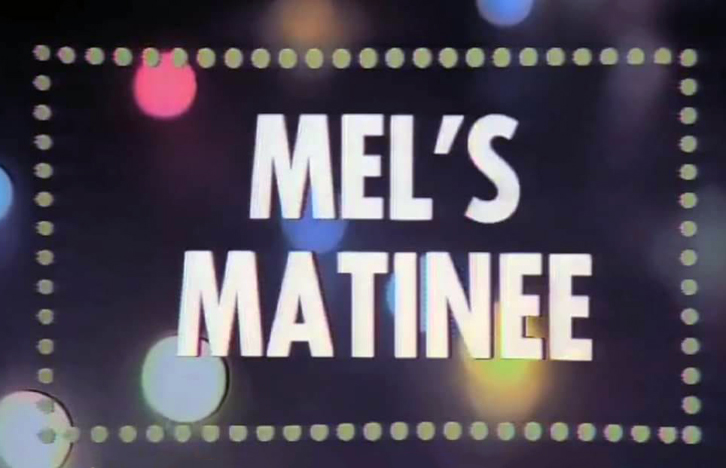
An interview show called “Mel’s Notebook” was shown on WTCN in the early afternoons (usually 2:45, right after the movie). It appears from late 1965 to spring 1969. It may have been shown at other times as well. Mel’s contract with WTCN was renewed in January 1965.
In 1970, WTCN won the rights to the show “Dialing for Dollars,” formerly the purview of KSTP. It aired twice per day – in a morning show at 10:00, and by Mel, in between movie segments during his Matinee Movie show at 1:00 pm. He would make four calls per show to find people who were watching the show.
In 1967, Irv Letofsky wrote a long article about Mel
Sellingest man on television
In real life, is just like he is on TV.
Most publicized dropout at Harding High School (not proud of)
Elements of the Big Sell:
Attention getting
Statement of product
Claims of product
Proof of claims
Ease of secure-ability
Action-getting statement
MORE MEL
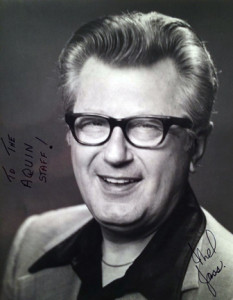
Photo courtesy of Patrick Sweeney
In addition to his regular shows, Mel was often out on assignment, interviewing beauty queens, hosting celebrities at the Aquatennial and Winter Carnival, representing sponsors’ products at the Indy 500, and generally being there when the station needed him. One early assignment (September 16, 1955) had him emcee “Pioneer Days,” a celebration for folks married 50 years or longer, at the Emporium Department Store in St. Paul.
Mel was best known for his bellicose delivery of commercials. Mel sold soap and cereal and spinach and the Furniture Barn, always with an irresistible pitch that may not have sold you a room of furniture, but made you smile at the man’s enthusiasm. He said he used or tested all of the products he sold, and was renowned for his ability to improvise 60-second pitches without rehearsal or cue cards. Many times Mel’s commercials were more entertaining than the movie. He called his style “aggressive humility.” His sincerity and ingratiating manner won viewers over while his powerful voice grabbed their attention and urged them to buy.
Mel was also known for his catch phrase “He’s got a good job,” often spoken to some kid who has just told Mel what his father does for a living. (They say he accidentally said that to a woman who told him that her husband was dead.)
Again acting, he played himself in a 1974 movie called “The Wrestler,” which was made in the Twin Cities with local actors (with a couple exceptions, including Ed Asner).
The last two Matinee Movies that Mel presented were:
- March 1, 1979: “By the Light of the Silvery Moon,” a vehicle for Doris Day and Gordon MacRae (1953), and
- March 2, 1979: “Cheaper by the Dozen,” with Clifton Webb and Myrna Loy (1950).
After 21 years, Mel and WTCN parted company on December 31, 1981.
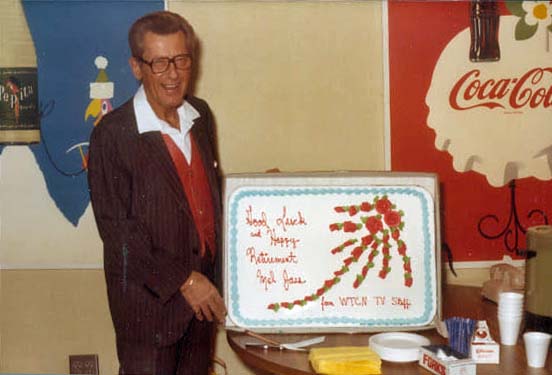
Mel’s Matinee Movie, a Twin Cities staple, was replaced by soap operas. WTCN became an NBC affiliate on March 5, 1979.
After that he was a freelance announcer for all of the local stations. There’s a school of thought that says that Mel worked for every local station except KSTP-TV, but then again someone said he worked for KSTP in 1987, in the aftermath of a purge at that station. In 1984 Mel was even voicing promos at KITN-TV Channel 29 (which had recently changed hands), so he even worked there (the station went on in the fall of 1982 as WFBT).
Mel died of heart failure at his home in Mound on January 20, 1997 and was cremated. He was survived by his wife, Lorraine, daughter Deborah Ash (Naugatuck, Connecticut), and sons Tom, David (both of San Diego), Paul (Salt Lake City), and Dan (Brooklyn Center).
AWARDS
In 2005 Mel was awarded the Silver Circle by the Upper Midwest Chapter of the National Academy of Television.
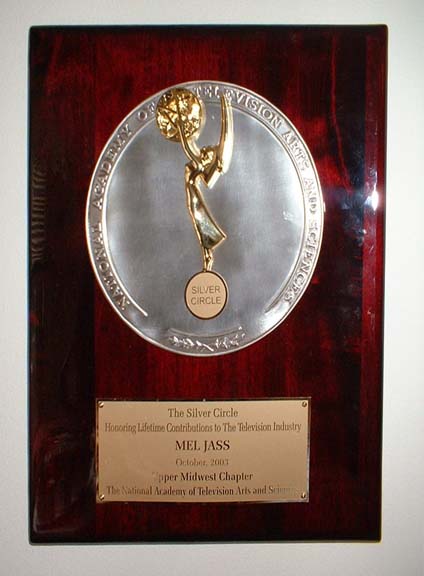
In 2007 Mel was inducted into the Museum of Broadcasting Hall of Fame.
MEL LIVES ON
There are many examples of Mel’s work on the Internet. Follow the Museum of Broadcasting’s link to see a reel of Mel’s brilliant pitchmanship! And those characters at TCMedia Now have unearthed a racy commercial that never hit the airwaves. YouTube must have many spots as well. Love him or hate him, he’s still a much-remembered Twin Cities local celebrity!
For more information on local television, see Twin Cities Television Milestones.

